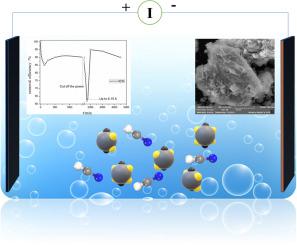Ecotoxicology and Environmental Safety ( IF 6.2 ) Pub Date : 2021-09-16 , DOI: 10.1016/j.ecoenv.2021.112784 Zhishuncheng Li 1 , Bangjin Chen 1 , Junyan Li 1 , Guangfei Qu 1 , Ping Ning 1 , Xi Ma 1 , Ruosong Xie 1

|
In this study, Co, Cu, Pd, and Pd/Cu composite metal ions were used to synthesize metal nanoparticles with high efficiency in purifying hydrogen cyanide gas. The pure liquid phase catalytic purification of hydrogen cyanide gas was studied. According to the removal rate, the Pd/Cu composite metal ions had the best purification efficiency among the nanoparticles of different metal types. The removal rate order was Pd/Cu>Pd>Cu>Co. The gas after reaction were analyzed by gas chromatography, and it was found that HCN was converted into CO2, N2 and NH3 by nanoparticles. Then, Pd/Cu composite metal ions with the highest purification efficiency were used to study the electrochemical synergistic liquid-phase catalytic purification of HCN gas. The effects of electrochemical conditions and current on the electro-hydraulic synergistic purification were studied. The removal efficiency of HCN by electrochemical synergistic liquid phase catalysis was better than that by pure liquid phase catalysis. The different nanoparticles before and after HCN absorption were characterized and analyzed to explore the purification process of HCN. The purification mechanism of hydrogen cyanide by Pd-Cu catalyst under applied voltage was studied under certain conditions. During the catalytic reaction, the nano-catalyst was partially dissolved in liquid phase and partially HCN reacts with metal ions on the free or nanoparticles to form complex [Mc(CN)n]2−n. Homogeneous and quasi-homogeneous reactions in liquid phase interweave together to form a more complex reaction system.
中文翻译:

电化学和液相催化协同作用高效纯化氰化氢
本研究利用Co、Cu、Pd和Pd/Cu复合金属离子合成金属纳米粒子,高效净化氰化氢气体。研究了氰化氢气体的纯液相催化净化。从去除率来看,Pd/Cu复合金属离子在不同金属类型的纳米粒子中净化效率最好。去除率顺序为 Pd/Cu>Pd>Cu>Co。反应后的气体经气相色谱分析,发现HCN转化为CO 2、N 2和NH 3通过纳米粒子。然后,利用净化效率最高的Pd/Cu复合金属离子,研究了HCN气体的电化学协同液相催化净化。研究了电化学条件和电流对电液协同净化的影响。电化学协同液相催化对HCN的去除效率优于纯液相催化。对HCN吸收前后的不同纳米颗粒进行表征和分析,以探索HCN的纯化过程。研究了在一定条件下外加电压下Pd-Cu催化剂净化氰化氢的机理。在催化反应过程中,2−n。液相中的均相和准均相反应交织在一起,形成更复杂的反应体系。











































 京公网安备 11010802027423号
京公网安备 11010802027423号